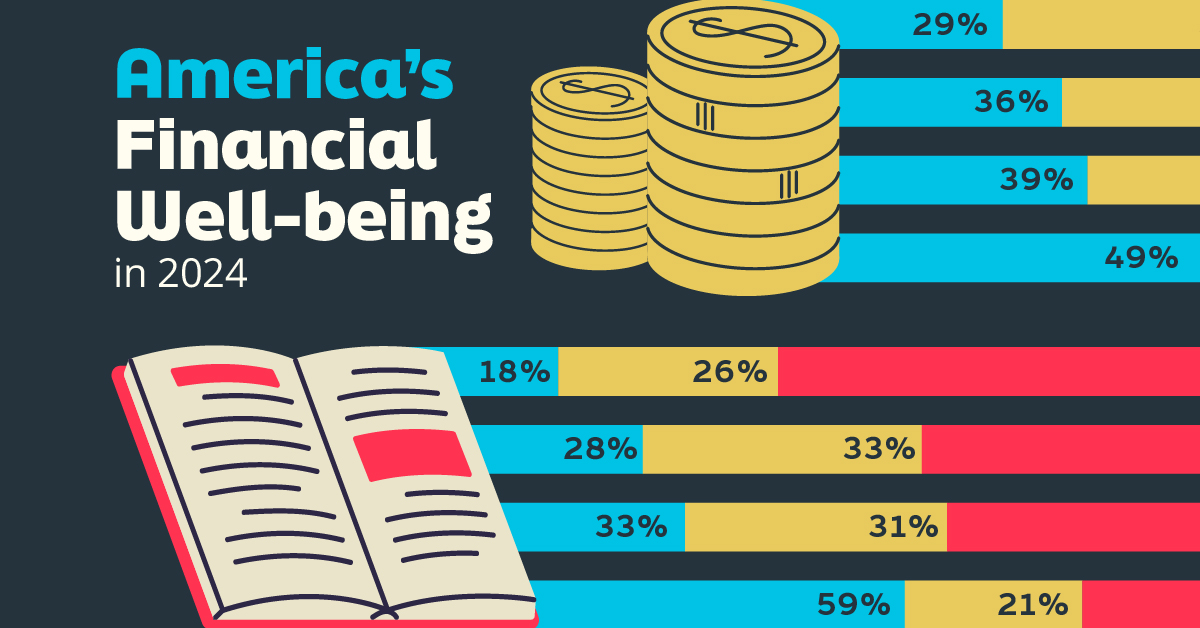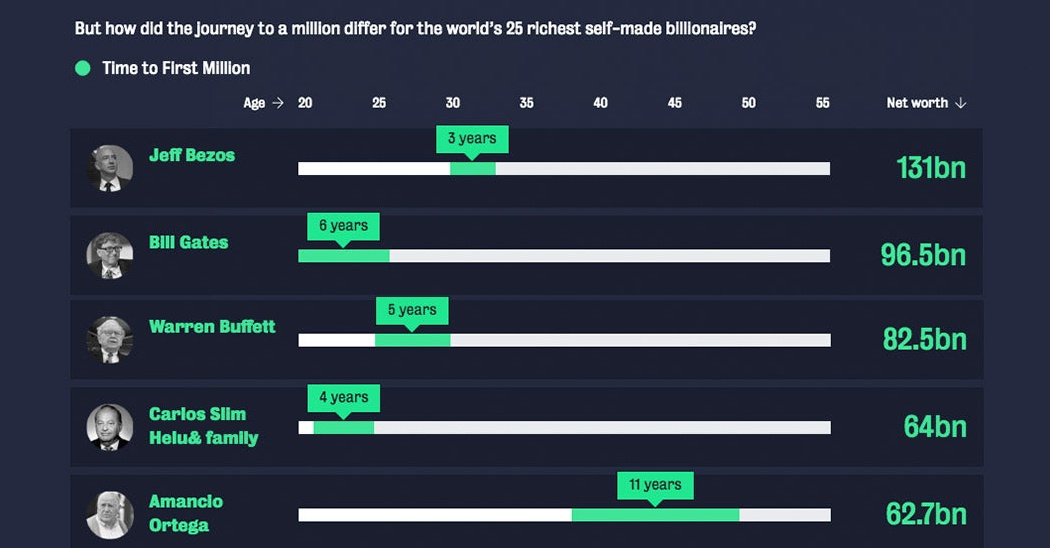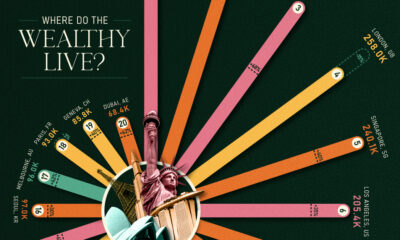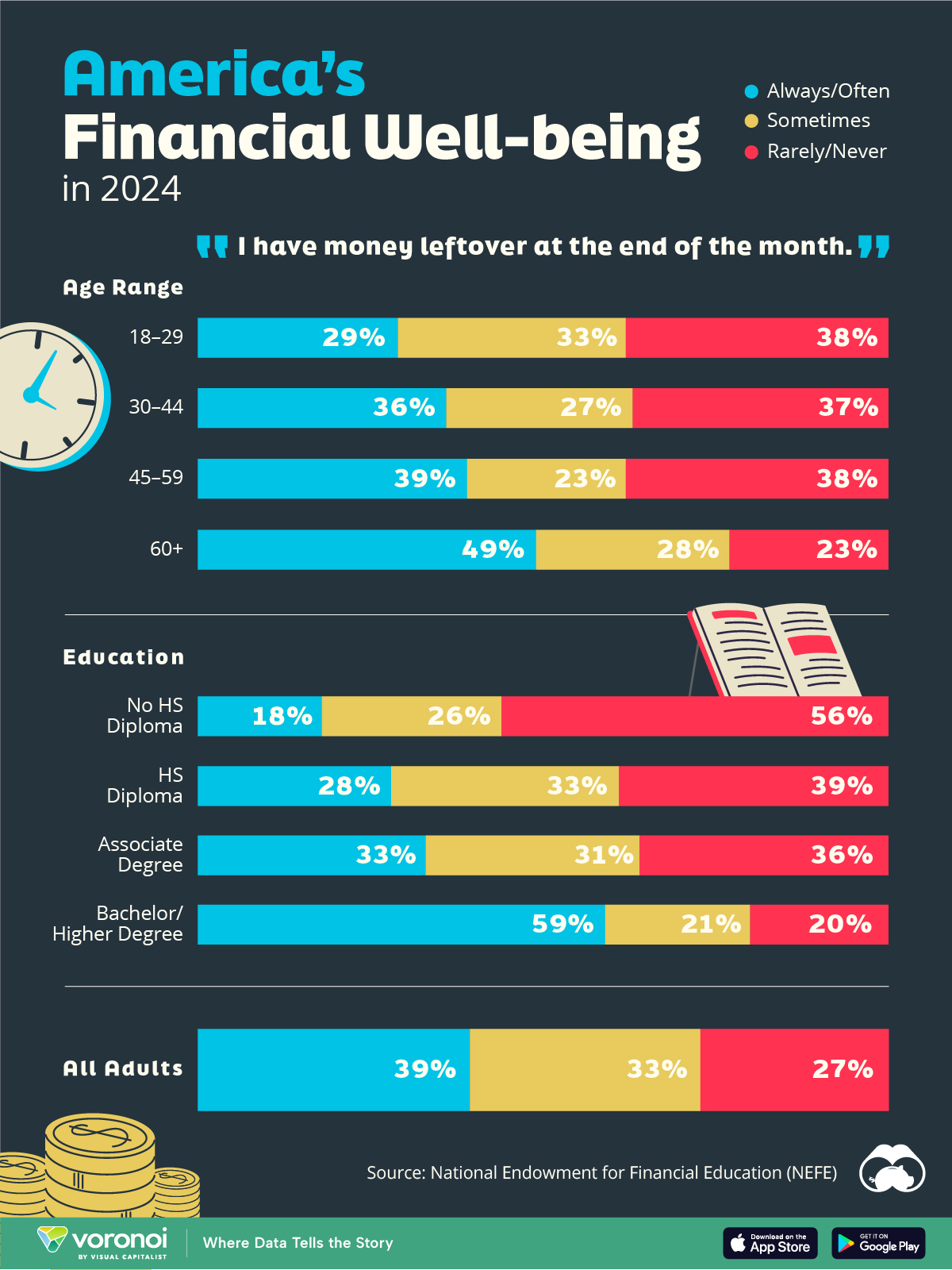Money
How Long it Took Billionaires to Earn Their First $1 Million

How Long it Took Billionaires to Earn Their First $1 Million
Everyone has to start somewhere.
While the modern fortunes of people like Jeff Bezos and Bill Gates seem stratospheric in size, even the world’s richest self-made billionaires had to crawl before they could walk.
After all, the journey to becoming ultra-wealthy hinges on earning that very first $1 million – the initial pillar of wealth that helps provide the security and confidence to go all-in on later ventures and investments.
The Typical Journey
Today’s infographic comes to us from Slotsia, and it compares the timelines of the wealthiest self-made billionaires showing how long it took them to each earn their first $1 million.
As it turns out, joining the Two Comma Club is rarely an overnight endeavor.
On average, it took about eight years to get to the $1 million mark, with the most common age for hitting the milestone at age 36, and business ventures being the top source of this wealth.
Milestone Time, by Years
Of the top 100 billionaires on he planet, 65 of them are self-made – and here’s how long it took each of them to earn their first $1 million:
| Time to hit $1 Million | Self-made billionaires | % of total |
|---|---|---|
| 0-5 years | 25 | 38% |
| 6-10 years | 20 | 31% |
| 11-16 years | 16 | 25% |
| 17-25 years | 4 | 6% |
Impressively, about 25 self-made billionaires, including people like Mark Zuckerberg, Jack Ma, and Wang Jianlin, were able to make this initial fortune in under five years.
Meanwhile, other founders like Phil Knight of Nike, took 16 years to hit the mark.
Milestone Time, by Industry
While the set of data is limited, here’s how long it took to hit the first million based on industry:
| Time to hit $1 Million | Industry |
|---|---|
| 3.0 years | Telecom |
| 4.8 years | Tech |
| 5.2 years | Metals & Mining |
| 5.8 years | Real Estate |
| 6.0 years | Diversified |
| 7.5 years | Automotive |
| 8.4 years | Energy |
| 9.5 years | Media & Entertainment |
| 9.5 years | Gambling & Casinos |
| 10.0 years | Finance & Investments |
| 10.0 years | Service |
| 11.25 years | Food & Beverage |
| 14.3 years | Fashion & Retail |
| 15.0 years | Construction & Engineering |
| 16.3 years | Manufacturing |
Billionaires in the telecom and tech sectors were the fastest to $1 million, while those in fashion, construction, and manufacturing businesses took much longer to get to the promised land.
Of course, reaching the first financial milestone is only one step in a much longer journey.
For further reading, see how long it took for the world’s wealthiest to make the jump from millionaire to billionaire.
Money
Charted: Who Has Savings in This Economy?
Older, better-educated adults are winning the savings game, reveals a January survey by the National Opinion Research Center at the University of Chicago.

Who Has Savings in This Economy?
This was originally posted on our Voronoi app. Download the app for free on iOS or Android and discover incredible data-driven charts from a variety of trusted sources.
Two full years of inflation have taken their toll on American households. In 2023, the country’s collective credit card debt crossed $1 trillion for the first time. So who is managing to save money in the current economic environment?
We visualize the percentage of respondents to the statement “I have money leftover at the end of the month” categorized by age and education qualifications. Data is sourced from a National Endowment for Financial Education (NEFE) report, published last month.
The survey for NEFE was conducted from January 12-14, 2024, by the National Opinion Research Center at the University of Chicago. It involved 1,222 adults aged 18+ and aimed to be representative of the U.S. population.
Older Americans Save More Than Their Younger Counterparts
General trends from this dataset indicate that as respondents get older, a higher percentage of them are able to save.
| Age | Always/Often | Sometimes | Rarely/Never |
|---|---|---|---|
| 18–29 | 29% | 33% | 38% |
| 30–44 | 36% | 27% | 37% |
| 45–59 | 39% | 23% | 38% |
| Above 60 | 49% | 28% | 23% |
| All Adults | 39% | 33% | 27% |
Note: Percentages are rounded and may not sum to 100.
Perhaps not surprisingly, those aged 60+ are the age group with the highest percentage saying they have leftover money at the end of the month. This age group spent the most time making peak earnings in their careers, are more likely to have investments, and are more likely to have paid off major expenses like a mortgage or raising a family.
The Impact of Higher Education on Earnings and Savings
Based on this survey, higher education dramatically improves one’s ability to save. Shown in the table below, those with a bachelor’s degree or higher are three times more likely to have leftover money than those without a high school diploma.
| Education | Always/Often | Sometimes | Rarely/Never |
|---|---|---|---|
| No HS Diploma | 18% | 26% | 56% |
| HS Diploma | 28% | 33% | 39% |
| Associate Degree | 33% | 31% | 36% |
| Bachelor/Higher Degree | 59% | 21% | 20% |
| All Adults | 39% | 33% | 27% |
Note: Percentages are rounded and may not sum to 100.
As the Bureau of Labor Statistics notes, earnings improve with every level of education completed.
For example, those with a high school diploma made 25% more than those without in 2022. And as the qualifications increase, the effects keep stacking.
Meanwhile, a Federal Reserve study also found that those with more education tended to make financial decisions that contributed to building wealth, of which the first step is to save.
-

 Markets1 week ago
Markets1 week agoU.S. Debt Interest Payments Reach $1 Trillion
-

 Markets2 weeks ago
Markets2 weeks agoRanked: The Most Valuable Housing Markets in America
-

 Money2 weeks ago
Money2 weeks agoWhich States Have the Highest Minimum Wage in America?
-

 AI2 weeks ago
AI2 weeks agoRanked: Semiconductor Companies by Industry Revenue Share
-

 Markets2 weeks ago
Markets2 weeks agoRanked: The World’s Top Flight Routes, by Revenue
-

 Countries2 weeks ago
Countries2 weeks agoPopulation Projections: The World’s 6 Largest Countries in 2075
-

 Markets2 weeks ago
Markets2 weeks agoThe Top 10 States by Real GDP Growth in 2023
-

 Money2 weeks ago
Money2 weeks agoThe Smallest Gender Wage Gaps in OECD Countries















